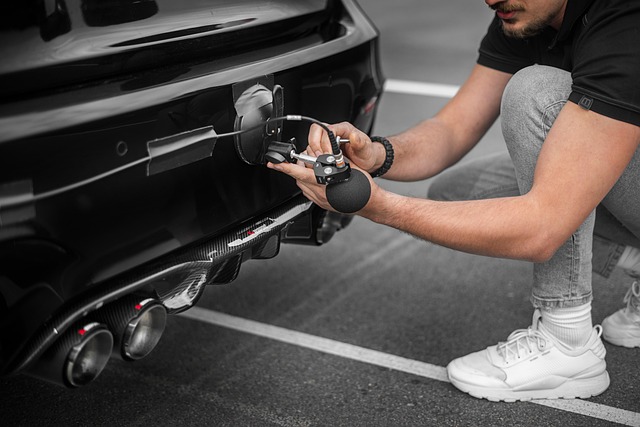Looking to register your car in California? This comprehensive guide breaks down the process step-by-step. From understanding crucial requirements and gathering essential documents to completing the application process, we’ve got you covered. A key part of the journey is the DMV’s VIN (Vehicle Identification Number) verification, ensuring your vehicle meets all standards. Ultimately, learn how to pay the registration fees and hit the road legally in The Golden State.
- Understand California Car Registration Requirements
- Gather Necessary Documents for Car Registration
- Visit Your Local DMV for VIN Verification
- Complete the Registration Application Process
- Pay the California Car Registration Fees
Understand California Car Registration Requirements

Before registering your car in California, it’s essential to understand the state’s specific requirements for vehicle registration. This process involves more than just filling out forms; it includes verifying the vehicle’s identity through a thorough inspection known as DMV VIN verification. This step is crucial to ensure that the car you’re registering is genuine and not stolen. The California Department of Motor Vehicles (DMV) conducts this verification by checking the Vehicle Identification Number (VIN), which is unique to each vehicle, against their records.
During the registration process, you’ll need to present a valid DMV form 19 (or equivalent) that includes the results of a mobile VIN verifier or mobile VIN inspection. This document confirms that the car’s VIN matches the information on file and ensures compliance with California’s strict anti-theft laws. It’s important to note that only authorized mobile vin verifiers can conduct this inspection, providing convenience and peace of mind for drivers looking to register their vehicles in the Golden State.
Gather Necessary Documents for Car Registration

Before heading to the California Department of Motor Vehicles (DMV), ensure you have all the essential documents for car registration. The process begins with verifying the vehicle’s identity through a DMV vin verification, which checks the Vehicle Identification Number (VIN) against their records. This step is crucial and can often be done online or via a mobile vin verification app for your convenience.
Gathering the necessary paperwork includes providing proof of ownership, such as a title document, along with valid identification like a driver’s license or state-issued ID card. Additionally, you’ll need to present evidence of insurance and complete an application form. Some jurisdictions might also require a vehicle inspection, known as a vin inspection, which can be arranged through specialized mobile vin verifier services for added flexibility.
Visit Your Local DMV for VIN Verification

Before you can register your car in California, you’ll need to ensure it meets certain safety standards. One crucial step in this process is visiting your local DMV for VIN verification. This involves having your vehicle’s Vehicle Identification Number (VIN) inspected to confirm its authenticity and make sure it complies with state regulations. The DMV will check critical components like the engine, transmission, brakes, lights, and other essential systems to ensure they function correctly and meet safety standards.
This process is often streamlined by utilizing mobile VIN verification services, which can provide an efficient alternative to visiting a physical location. These services send an inspector to your convenience, whether it’s at your home or workplace, to perform the necessary checks. This not only saves you time but also proves that technology can enhance the traditional DMV experience, making vehicle registration smoother and more accessible for California residents.
Complete the Registration Application Process

Once you’ve gathered all the necessary documents, it’s time to complete the registration application process with the DMV. This involves filling out a vehicle registration form, providing proof of insurance, and undergoing a DMV VIN verification. The latter ensures that your vehicle’s unique Vehicle Identification Number (VIN) is accurate and matches the data in their system. You can facilitate this process by utilizing a mobile vin verifier to get the job done swiftly and conveniently.
After your vin inspection, submit all required documents to the DMV, including your vehicle’s title and any applicable fees. They’ll review your information and, if everything is in order, issue you a registration certificate, which will include a unique California license plate for your car.
Pay the California Car Registration Fees

After completing your California car purchase, it’s time to register your vehicle with the Department of Motor Vehicles (DMV). Before proceeding, ensure you’ve arranged for a safety inspection and passed the emissions test, if required for your make and model. Once ready, head to a local DMV office or use their online services to initiate the registration process.
During this process, you’ll be responsible for paying the necessary fees, which include a registration fee and possibly a title transfer fee, depending on whether you’re registering a new or used car. The California DMV also offers a convenient mobile vin inspection service, allowing you to verify your vehicle’s identity (VIN) without visiting an office. This step is crucial for ensuring that all documentation is accurate before finalizing your car’s registration.
Registering a car in California is a straightforward process that requires understanding the state’s requirements and gathering the necessary documents. By completing the steps outlined, including successful DMV VIN verification, submitting the registration application, and paying the associated fees, you’ll have your vehicle legally registered in no time. Remember to keep your documentation up-to-date for seamless future renewals.
